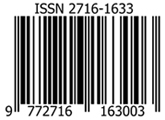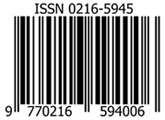HUJAN PRESFEKTIF AL-QURAN DAN SAINS
Abstract
Full Text:
PDFReferences
Al-Alusi. 1932. Ruh al-Ma’ni fi Tafsir al-Quran al-‘Azimwa al-Sab’u al-Masani, Beirut: Dar al-Fikri.
Baqi, Abdul, M. Fuad. 2007. Muʹjam al-Mufahras li al-Fadz al-Quran al-Karim, Beirut: Dar elHadith.
Ibrahim. 1986. “Sisi Mulia al-Quran: Agama dan Ilmu, terj. Aly Abu Bakar Basallamah dan Asmin’’, Jakarta: Raja Wali.
Habibah, Umi Dkk. 2010. “Ilmu Pengetahuan Alam 5”, (Jakarta:CV.Mitra Media Pustaka.
Halim, Abdul Samir, dkk. 2015. “Ensiklopedia Sains Islami Geografi”, Tangerang:PT. Kamil Pustaka.
Hanafi, Muchlis M. 2012. Pelestarian Lingkungan hidup (Tafsir al-Qur’an Tematik), (Jakarta: Lajnah Pentashih Al-Qur’an.
Hartono2009. Geografi 1 Jelajah Bumi dan Alam Semesta untuk Kelas X SMA/MA, Jakarta: CV.Citra Praya.
Morris Neiburger. 1995. “Understanding our Atmospheric Environment, “diterjemahkan Ardina Purbo. Memahami Lingkungan Atmofer Kita” Edisi II Bandung.
Munawwir Warison, Ahmad,. 1997. Al-Munawwir: Kamus Arab-Indonesia, Surabaya: Pustaka Progresif.
Rizaldy Fatha Pringgar, Bambang Sujatmiko,. 2020. Penelitian kepustakaan (Library Riseartch) Modul Pemblajaran Berbasis Augmated Realiti pada pemblajaran Siswa, IT-Edu: Jurnal Information Technology and Education, Vol. 5, 01.
Suharso dan Retnoningsih, Ana2005. Kamus Besar Bahasa Indonesia, Semarang: CV Widya Karya.
Shihab, Qurais, Muhammad. 2002. Tafsir al-Misbah Pesan Kesan dan Keserasian al-Quran, Vol. 11, Jakarta: Lentera Hati.
Refbacks
- There are currently no refbacks.

This work is licensed under a
Creative Commons Attribution-NonCommercial-ShareAlike 4.0 International License.




